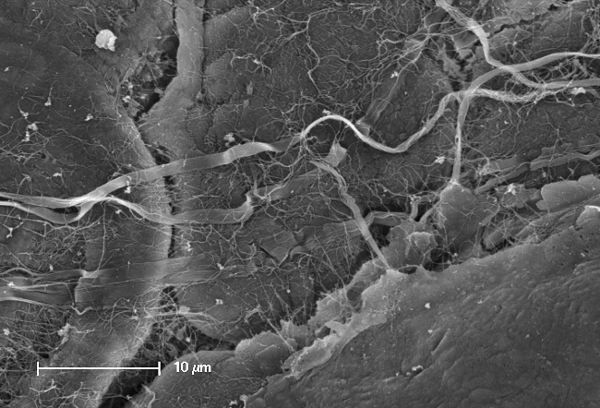In the journey through the cell suggested by C. de Duve (A guide tour of the living cell. Scientific American books, vol. 2, 1984) a molecular-sized cytonaut traveling toward a cell, before reaching the plasma membrane, would first need to go through a jungle of stems, branches, rain forest vines, and lianas. In tissues, this messy tangle is the extracellular matrix. The extracellular matrix is a scaffold of proteins and carbohydrates located around the cells that is synthesized and released by the cells themselves.
The extracellular matrix was invented by multicellular organisms. It was necessary to keep cells together by adhesion, and therefore tissues appeared. During evolution, extracellular matrix got many other functions besides adhesion, such as being responsible for the mechanical properties of most tissues (both in plant and animals), maintaining cell morphology, allowing cell communication, establishing pathways for cell migration, modulating cell differentiation and physiology, maintaining growth factors in some places, and many other functions. In tissues, features like resistance, hardness, elasticity, hydration or optical properties, depend on the extracellular matrix features.
The extracellular matrix as a fundamental component of tissues and organs is shown in many pathologies. The miss-functioning of extracellular matrix molecules underpins a wide variety of diseases.
The amount of the extracellular matrix depends on the tissue. In animals, there are tissues, such as epithelia and nervous tissue, containing a low amount of extracellular matrix, while in connective proper, cartilage, and bone, the extracellular matrix occupies most of the tissular volume (Figure 1). The molecular components of the extracellular matrix change from one tissue to another, and are continually renewed. Synthesizing and removing the extracellular matrix is a constant work that cells do.

The main molecules that form the extracellular matrix of animals are: structural proteins such as collagen and elastin, glycosaminoglycans, proteoglycans and glycoproteins (Figures 2 and 3). In plants, the cell wall is made up of carbohydrates , such as cellulose, hemicellulose and lignin. All of them are in an aqueous environment, along with other smaller molecules, as well as ions. It is the amount, proportion and type of each type of these molecules what make the differences between the extracellular matrices.


In plant tissues, the cell wall can be regarded as a very specialized extracellular matrix, quite different compared to the animal extracellular matrix. The cell wall provides stiffness to the cell, plant tissues and to the whole plant body. It is a barrier to water diffusion and protects against pathogens and mechanical damages.
Cells communicate with the extracellular matrix through membrane proteins, mostly integrins, which are transmembrane adhesion proteins that recognize and bind to extracellular matrix molecules. Cells also respond to molecules release from the extracellular matrix. These cell-extracellular matrix interactions are involved in differentiation, survival, cell migration, proliferation and tissue homeostasis.
 Endosymbiosis
Endosymbiosis 